In the back of my garden, I have a small patch of fennel (Foeniculum vulgare) that grows year-round and stands five feet tall. Sometimes I’ll harvest the fronds for a salad or a bulb for my favorite seafood stew, or even the pollen or seeds for my cooking, but for the most part, I let the fennel grow “wild” here as part of a natural butterfly garden.
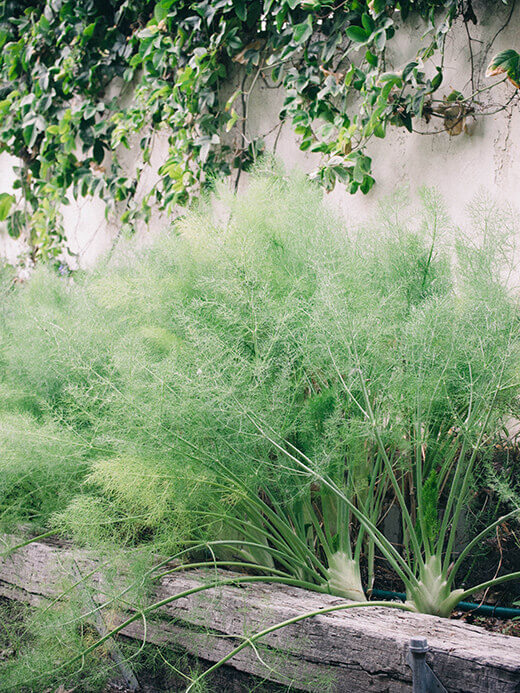
Aside from being edible and beautiful with wisps of anise fragrance wafting through the air, it also happens to be a beneficial plant that functions as a trap crop.
What does it trap? Parsleyworms, the striking caterpillars that eventually turn into swallowtail butterflies.
West of the Rockies, parsleyworms are the beginnings of the anise swallowtail butterfly. Its eastern version is the black swallowtail butterfly, and while the butterflies look distinctly different, their caterpillars and chrysalises are nearly identical.
Read more: Caterpillar Identification: A Visual Guide to 32 Types of Green Caterpillars in Your Garden
Parsleyworms are so named because they feed on members of the parsley family, Apiaceae, including parsley, dill, carrot, Queen Anne’s lace, and of course, fennel.
They can be found in all stages of life on these host plants, and it’s truly fascinating to revisit your plants each week to see their natural transformation. As the parsleyworm eats and grows, it sheds an exoskeleton and emerges with a completely different appearance. In total, it goes through five instars (stages) of life.
Here’s the first (or possibly second) instar…
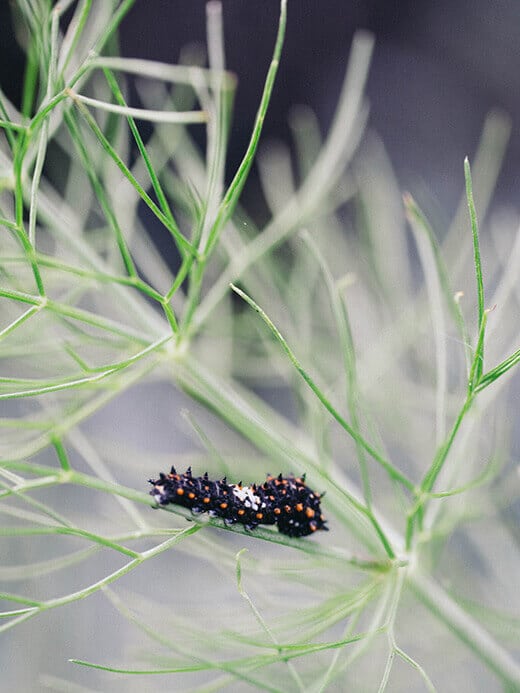
The third instar…
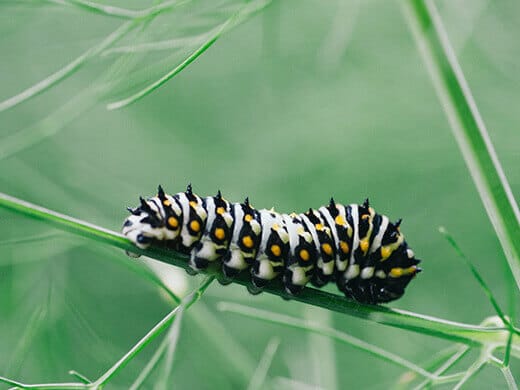
The fourth instar (where it turns into the plump black-and-green striped caterpillar that you may be most familiar with)…
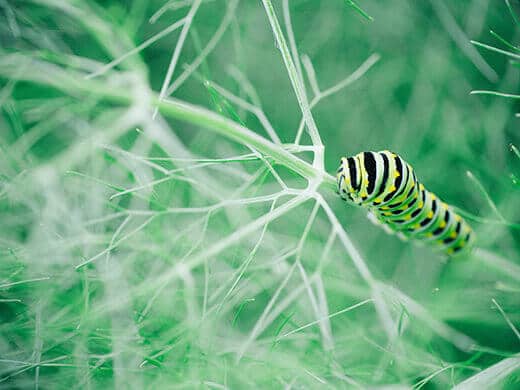
And the fifth and final instar, also known as the chrysalis stage. It’s from here that the parsleyworm pupates and emerges as an adult butterfly.
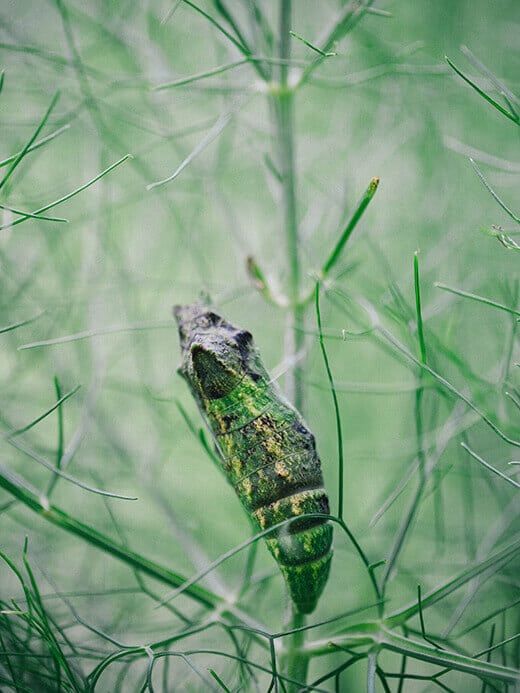
Since swallowtail butterflies lay their eggs on any member of the Apiaceae family, you might occasionally find them on your carrots or parsley as well. They have large appetites, so unless you planted enough for yourself and the butterflies, it can be a depressing sight to see your food crop munched down to its stems by an army of hungry caterpillars.
Planting a separate crop of fennel (or any related member) can help preserve the butterflies in your garden. I especially like Florence fennel, or finocchio, a bulbing variety that gives you a vegetable, an herb, and two spices over its lifespan. It’s a cool-weather crop that can be planted after the last frost for a spring harvest, or mid to late summer for an autumn harvest.
If you find a parsleyworm feeding where it shouldn’t be feeding, you can simply relocate it to your fennel patch and at the end of the season, you’ll still have some bulbs to harvest. A win all around.
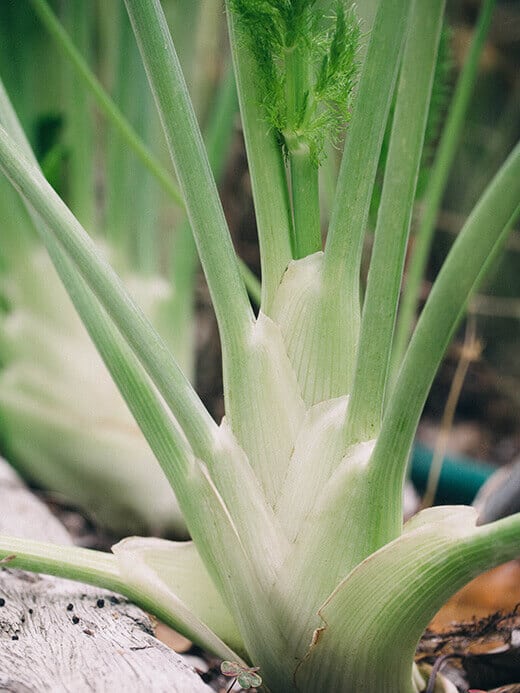

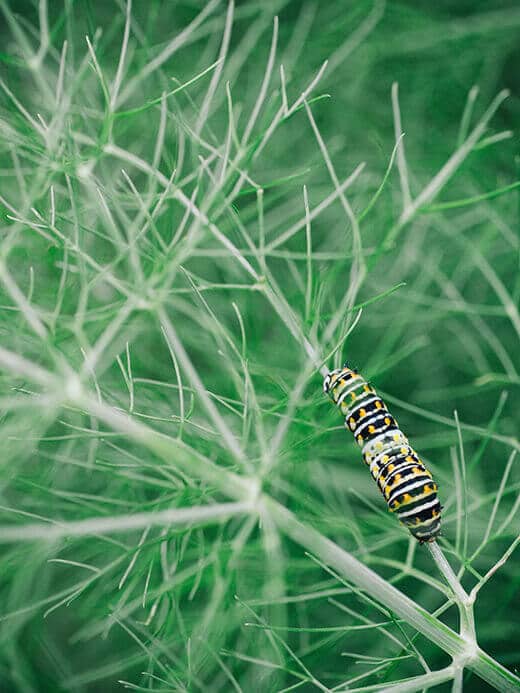
















I have a small patch of fennel and a patch of bronze fennel, both were planted about 4 years ago. I only started noticing in the past two years that the butterflies seem to love devouring the plant. I enjoy watching them throughout their growth – especially when they cocoon.
The cocoons are so beautiful! Like little ornaments on the plants. 🙂
“FENNEL FOR THE BUTTERFLIES” What a great crop to let grow “wild”…http://t.co/fCNYnaA3j0
Plant a separate crop of fennel to feed the parsleyworm caterpillars. Fennel For the Butterflies http://t.co/60Os6Pbh42 #gardenchat
The swallowtail butterfly can be found in all life stages on this host plant. Fennel For the Butterflies http://t.co/8HZJSoR1oU #gardenchat
RT @theGardenBetty: Want to attract butterflies to your garden? Swallowtails love this food crop. Fennel For the Butterflies http://t.co/Gz…
Charlie Bourgeois liked this on Facebook.
Joan Anderson liked this on Facebook.
James Bourgeois liked this on Facebook.
Want to attract butterflies to your garden? Swallowtails love this food crop. Fennel For the Butterflies http://t.co/Gzvycm4CxH #gardenchat
RT @theGardenBetty: The anise and black swallowtail butterflies begin their lives as parsleyworms. Fennel For the Butterflies http://t.co/J…
The anise and black swallowtail butterflies begin their lives as parsleyworms. Fennel For the Butterflies http://t.co/JIbNI2hN58 #gardenchat
Guess we don’t want these in the chicken area or parsleyworms will be the daily treat! CONGRATS on the Where Women Cook issue! I just voted on the cover through Stampington.
Ohhh I didn’t know there was voting going on for the cover! Thank you!
Patti Herdell liked this on Facebook.
Fascinating! I have a patch of fennel gone wild in the back of my garden too but was unaware of this. Will look now! Have seen a few beautiful swallowtails around the yard.
How cool.
Jessica Riozzi liked this on Facebook.
Scotty Scott liked this on Facebook.
Nikki Boden liked this on Facebook.
Sylvia Orr liked this on Facebook.
Carolyn Harvey liked this on Facebook.
Roger Maxim liked this on Facebook.
Greg Towne liked this on Facebook.
Marty Ashton-Thomas liked this on Facebook.
Greg Hadel liked this on Facebook.
Plant fennel as a trap crop for parsleyworms and watch their transformation. Fennel For the Butterflies http://t.co/IfyU29ADi0 #gardenchat
Brandi Young liked this on Facebook.
Laurie Smith liked this on Facebook.
Helga Galardi liked this on Facebook.
Vanessa Bolden liked this on Facebook.
Marjorie Pitts liked this on Facebook.
Looks so pretty but it’s seriously invasive in my area of So Cal. I’ve never planted it but find it popping up where I removed the lawn and do my best to remove it!
Fennel can be invasive, but like any plant, you can grow it responsibly in your garden and treat it as an annual, if need be.
Susie Merry Johnson liked this on Facebook.
I always have bronze fennel planted for the butterflies. I have all the stages of growth, from eggs to butterfly, photographed (macro) of the black swallowtail butterfly. I also discovered that aphids like the fennel and that attracts ladybugs. I have many stages of their growth photographed as well. I was starting in on photos of lacewings when winter hit. My one huge plant was an ecosystem in itself! This year my fennel doesn’t have any critters on it. Not yet at least.
Isn’t it incredible how a single plant can be host to such wildlife? I love it. 🙂
Jarin Yinyin liked this on Facebook.
Lydia Ann liked this on Facebook.
Ning Thanasorn liked this on Facebook.
Jacq Davis liked this on Facebook.
North by Northwest Farm liked this on Facebook.
Abigail Ryder liked this on Facebook.
Laura Kassler Gaines liked this on Facebook.
Blogged on Garden Betty: Fennel For the Butterflies http://t.co/ahjioVjXTV